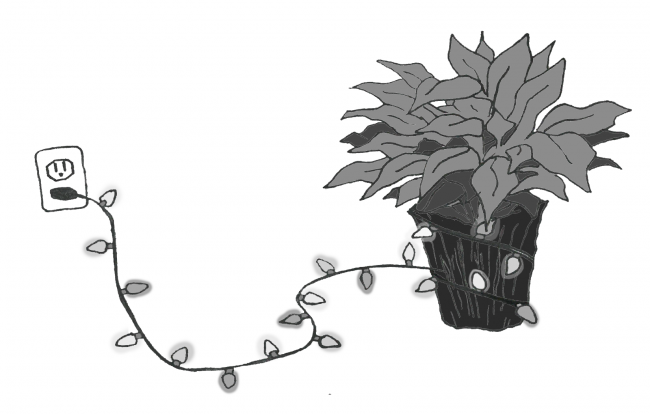I realize that most people consider poinsettias to be a holiday or Christmas flower. They are sold in excess during this time of year as they are one of the few flowers that are easily available in winter.
There are many reasons to like them. They can brighten up a room with their vibrant red color. They represent the spirit of the holiday season; however, I still hate them. Poinsettias are misrepresented and essentially are the “fake news” of plants.
First, the red part of the plant that most people adore is not a collection of petals. In contrast, they are ornamental leaves that surround the real bud of the poinsettia, which is the tiny yellow middle part. This is the primary reason that I personally do not like them. I think it would be disheartening to see any common symbol of the holidays seemingly defaced and then revealed to be something different.
In my research to learn more about poinsettias, I came across something that even further supports my opinion that these plants are heavily misrepresented. In the “Poinsettia Pages” of the University of Illinois Extension, I discovered that poinsettias are native to Mexico and cannot survive in cold temperatures easily at all. Poinsettias are literally nicknamed the Christmas plant and would not even be accessible in Christmas without international trade and greenhouses. It has also been stated on this website that these flowers would thrive best in “Southern California beach communities.” So, what I would like to know is why poinsettias are a crucial and easily recognizable symbol of Christmas and the holiday season?
I can’t help but see this plant as just another way to commercialize Christmas and any other winter holiday. The “Poinsettia Pages” state that these flowers are highly lucrative with their title of being America’s favorite Christmas plant. Poinsettias compound about $60 million dollars over a six-week period during the holiday season, and overall gives the economy of the United States an extra $250 million in sales.
All inclusive, poinsettias are in fact tiny yellow flowers, cannot withstand cold even though they represent the season, and encourages the commercialism of Christmas by being a holiday symbol that does not even fit the portrayal. A scenario equivalent to this is having a giraffe be the mascot for a meat product when a lion in also available. Clearly, the giraffe was not the best choice. Similar to this, there are other plants that actually bloom in the cold that would be a better fit to take the title of Christmas flower.
One widely common plant is the holly. It may not be widely known for its small, white flowers, but itd brightly colored berries and dark green leaves are perfect for wreaths. These shrubs are even at their best in winter as their berries would have just turned red. Even if the public would like to keep their tropical, heavily commercialized, yellow flower, that is fine because this season is not about the plants, it is about being around family, celebrating whatever holiday you celebrate, and showing kindness and care during the season.
Jasmine Demir
jkdemir@vwu.edu
The poinsettia, or “Christmas star,” is a plant that has become synonymous with Christmas. Many critique the poinsettia for its appearance, being mostly leaves and the flower itself being quite minuscule. However, regardless of how you feel about poinsettias, one cannot help but admit that they are a staple of the Christmas season. Displaying poinsettias at Christmastime is a long-standing tradition that many have become attached to over the years. I can speak from experience with the church I intern for that people take their poinsettias seriously.
During a work meeting one evening when discussing what color poinsettias would be used to decorate the sanctuary, an argument ensued about the possibility of ordering white and gold poinsettias rather than red. Apparently, white and gold poinsettias were used to decorate the sanctuary years before. That year, a particular individual got a murderous look in his eye in response to the floral array. According to one person, this individual looked as though he wanted to “burn the church down.” This illustrates how intense many traditionalists are about poinsettias at Christmastime. If poinsettias simply weren’t used, turmoil would rage within traditional communities. In order to maintain peace and prevent distractions from what the season is really about, I support the tradition of using poinsettias at Christmastime.
I also support the tradition of poinsettias at Christmastime since it provides a medium through which we can celebrate and learn about other cultures. The plant has become associated with the Christmas holiday as a result of a Mexican legend. According to the story, children in Mexico were required to present gifts to the baby Jesus during Christmas Eve church services. One poor child picked up weeds on the road side for her offering. As the child presented the weeds at church, they transformed before the congregation’s eyes into what we know as the poinsettia. Using poinsettias at Christmas time is way that we as Americans can celebrate other cultures and develop a sense of cross-cultural unity. This is especially important for our country today given the current political climate.
Despite the flower’s drab appearance, I think there is something beautiful in the story that underlies its use at Christmas time. The story shows how even something as ugly as weeds can be transformed. This is similar to the story of the lotus flower, a gorgeous flower which ascends from the mud in a marvelous display.
Some additional fun facts about the poinsettia: the flower was actually used during the time of the Aztecs in order to produce purple dye. Additionally, the poinsettia can grow up to 12 feet in its natural habitat. Therefore, we in America only get a taste of its true beauty.
Many people will say that it’s time to abandon the tradition of using poinsettias in Christmas displays and decorations. However, poinsettias at Christmastime is a tradition that has withstood the test of time. As far back as the 1800s, people were using poinsettia’s to help ring in the season. Why should we stop now?
Ashley Kline
aakline@vwu.edu


